Want some homemade gravy but don’t have drippings from a roasted chicken or turkey? This recipe for gravy without drippings uses simple, everyday ingredients and comes together quickly. Plus, it tastes so yummy!
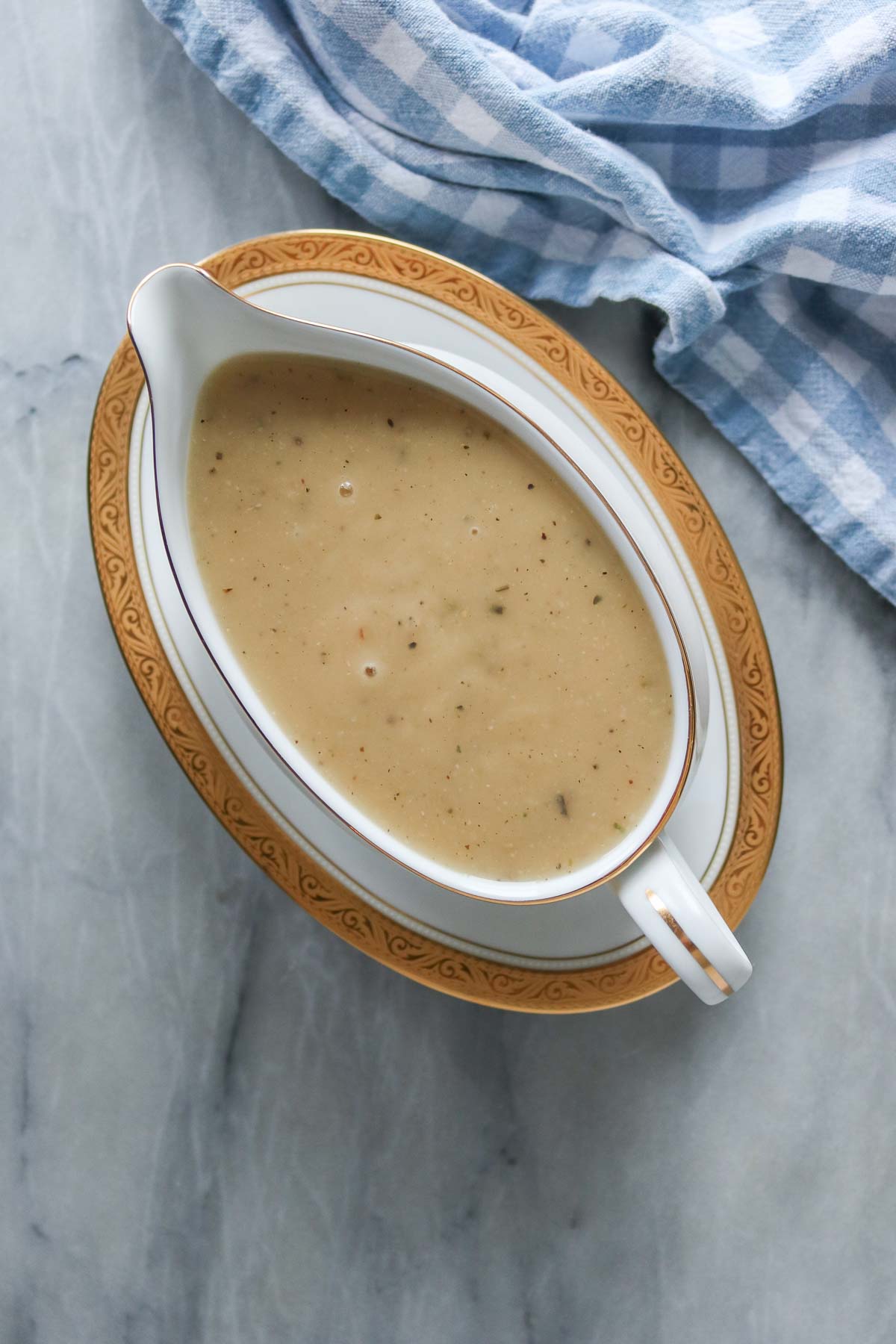
Find yourself in a gravy situation? Need gravy for those creamy mashed potatoes or hot turkey sandwich? Or just have a hankering for some fries with gravy — always the case with me — only to realize you don’t have any gravy on hand?
Well, not to worry! Homemade gravy is the way to go. It’s made in about 20 minutes and no drippings are required. Plus, it’s so much better than the canned stuff.
What Are Drippings?
Drippings are the juices and fat (or grease) that have accumulated in the pot or pan after you roast something, like turkey, chicken, or beef.
Drippings are absolutely flavour packed and are typically used as the base of many homemade gravy recipes.
As you can probably imagine, drippings from a freshly cooked turkey, chicken or beef roast make the best gravy. However, it’s not every day that you’re going to have those on hand. For days when you want to make gravy but don’t have drippings at the ready, that’s when this easy gravy recipe is handy to have in your back pocket.
Ingredients Needed
- Unsalted butter: I like to use unsalted butter and add salt to taste after the gravy is made.
- All-purpose flour: Flour (along with the melted butter) helps to create what is known as a “roux.” A roux is simply equal parts melted fat (like butter) and flour. It’s what creates the base for the gravy and thickens it.
- Seasonings: Seasonings for this gravy recipe are onion powder, garlic powder, Herbes de Provence, Worcestershire sauce, salt and black pepper. If you feel you’d like to add a little more of a particular seasoning, go for it.
- Chicken broth: Store-bought chicken broth is what is used in lieu of drippings. I used a reduced sodium chicken broth. If you use a no salt added variety or a regular variety, the amount of salt you add at the end will likely vary, depending on your tastes.
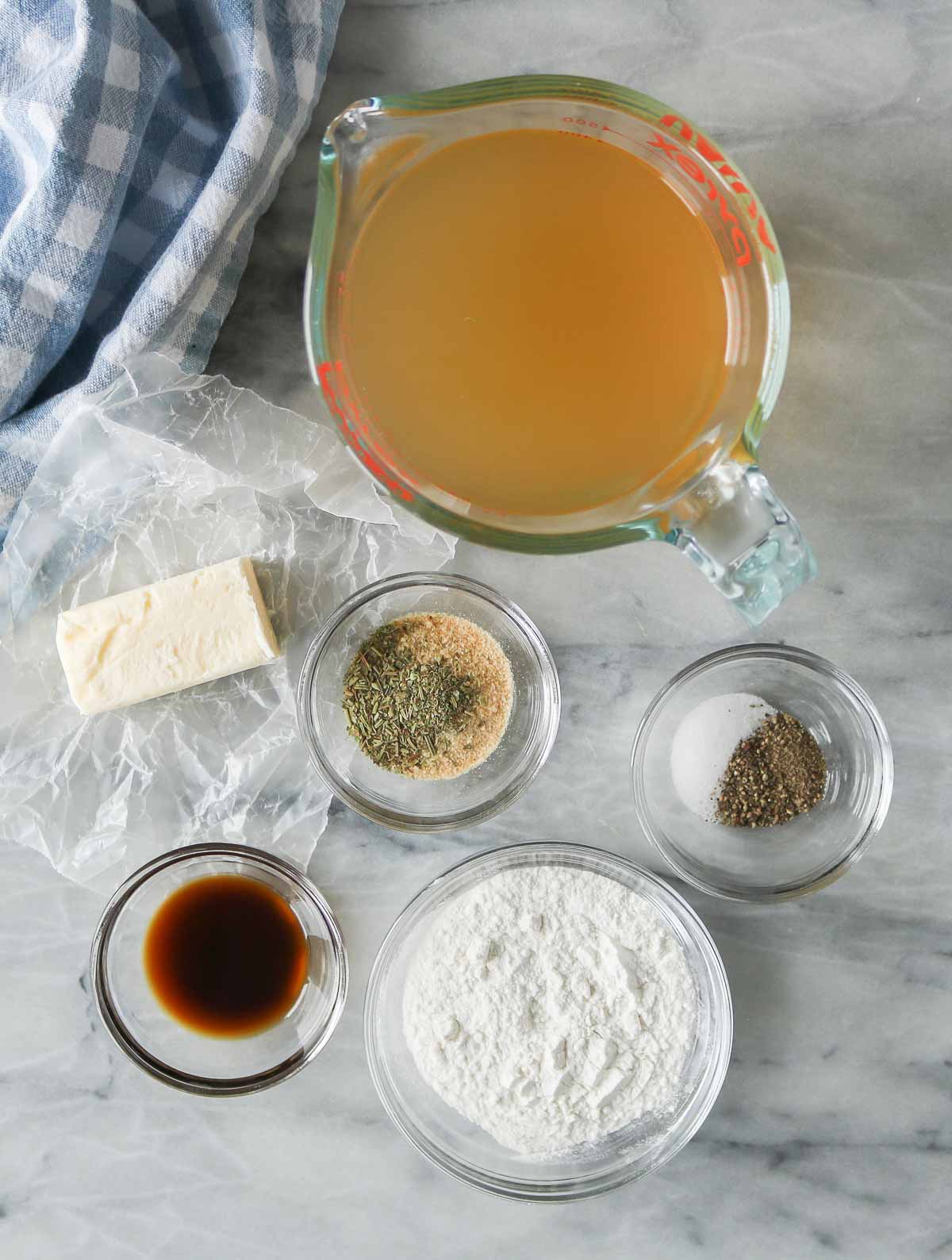
How Do I Make Gravy Without Drippings?
Here is an overview of how to make homemade gravy when you don’t have drippings (full details are in the recipe card below):
- Melt butter in a saucepan.
- Once the butter is melted, stir in flour. Whisk to combine and cook for a tad just to cook off the flour taste.
- Stir in onion powder, garlic powder and Herbes de Provence.
- Slowly whisk in some chicken broth, a little at a time and allowing the mixture to cook and thicken slightly after each addition, until you’ve reached your desired consistency.
- When the gravy nicely coats the back of a spoon, it should be good to go. At this point in time, the gravy is somewhat like a blank canvas. There’s seasoning in there, yes, and you have a gravy consistency, but there’s not a whole lot going on taste-wise. So, that’s when you want to stir in Worcestershire sauce and season to taste with salt and black pepper. That’s what brings the whole thing together!
- Pour that deliciousness into a gravy boat, then serve. Easy!
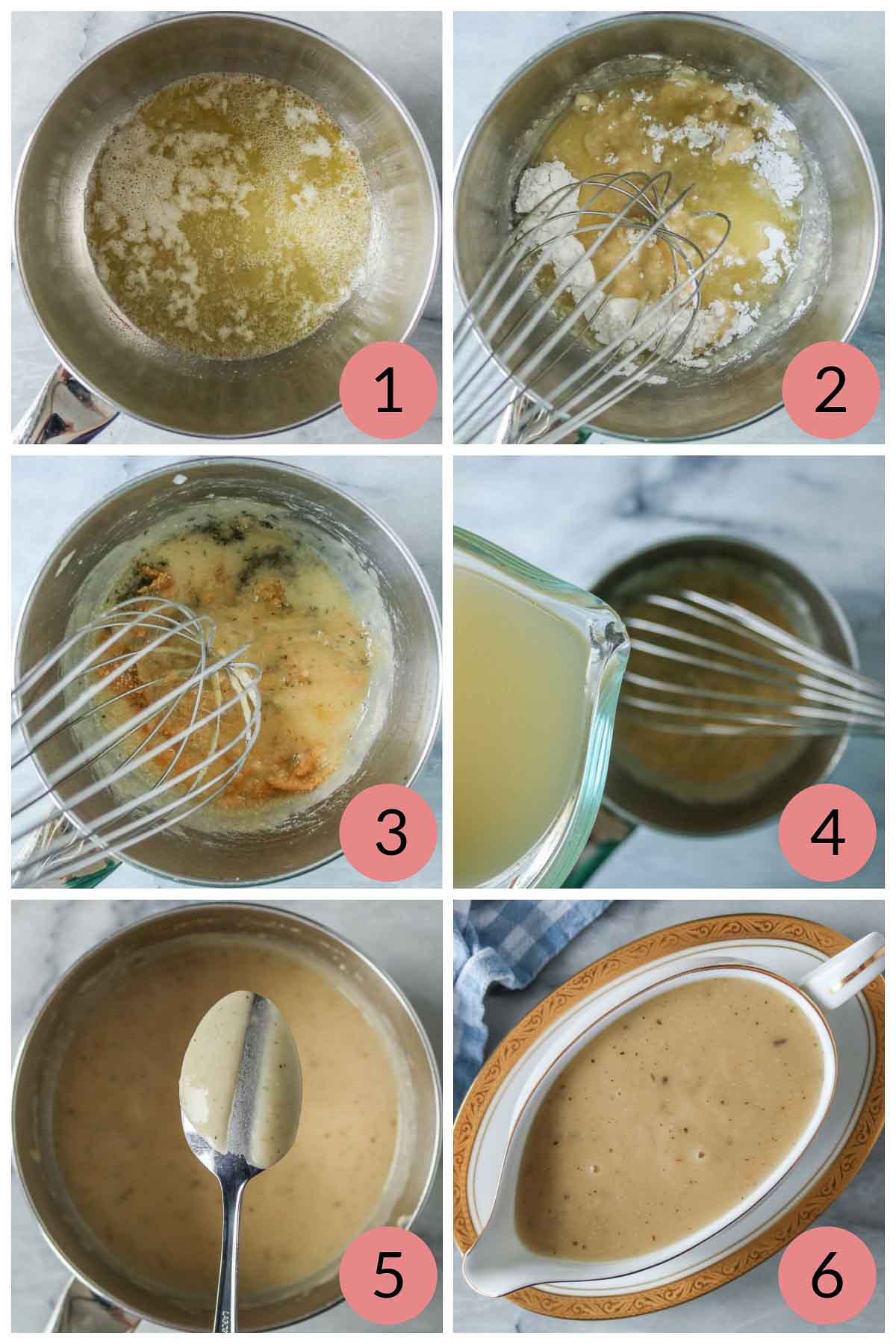
The Seasonings
As mentioned above, the seasonings for this gravy recipe are onion powder, garlic powder, Herbes de Provence, Worcestershire sauce, salt and black pepper.
I absolutely love to use Herbes de Provence in this gravy recipe. It may sound fancy, but it’s essentially a blend of herbs and can typically be found in your grocery store right alongside other dried herbs and seasoning mixes.
Herbes de Provence is usually made with herbs, such as rosemary, marjoram, summer savoury, oregano, thyme, tarragon and lavender.
If you don’t have any Herbes de Provence on hand or prefer not to use, no worries! You can substitute with some rosemary, marjoram, summer savoury, thyme or poultry seasoning.
Also, I used onion powder and garlic powder (versus using fresh onion and garlic). If you’d prefer to use fresh, you could simply sauté some onion and garlic in a little butter or cooking oil before proceeding with the recipe. After the gravy is made, you could then strain out the garlic and onion or leave in — whatever you prefer.
Tip: Everyone has a different preference for seasoning. If you feel like you’d like a little more of a particular ingredient (e.g. Herbes de Provence or Worcestershire sauce), add some.
Add More Colour With Gravy Browning
Gravy browning is something that is commonly found in Newfoundland. It’s typically made with things like caramel colouring, molasses and seasonings. The main use for it is, well, you guessed it: to brown gravy. If you want to give your homemade gravy more of a richer, browner hue, feel free to add some gravy browning until you’ve reached your desired colour.
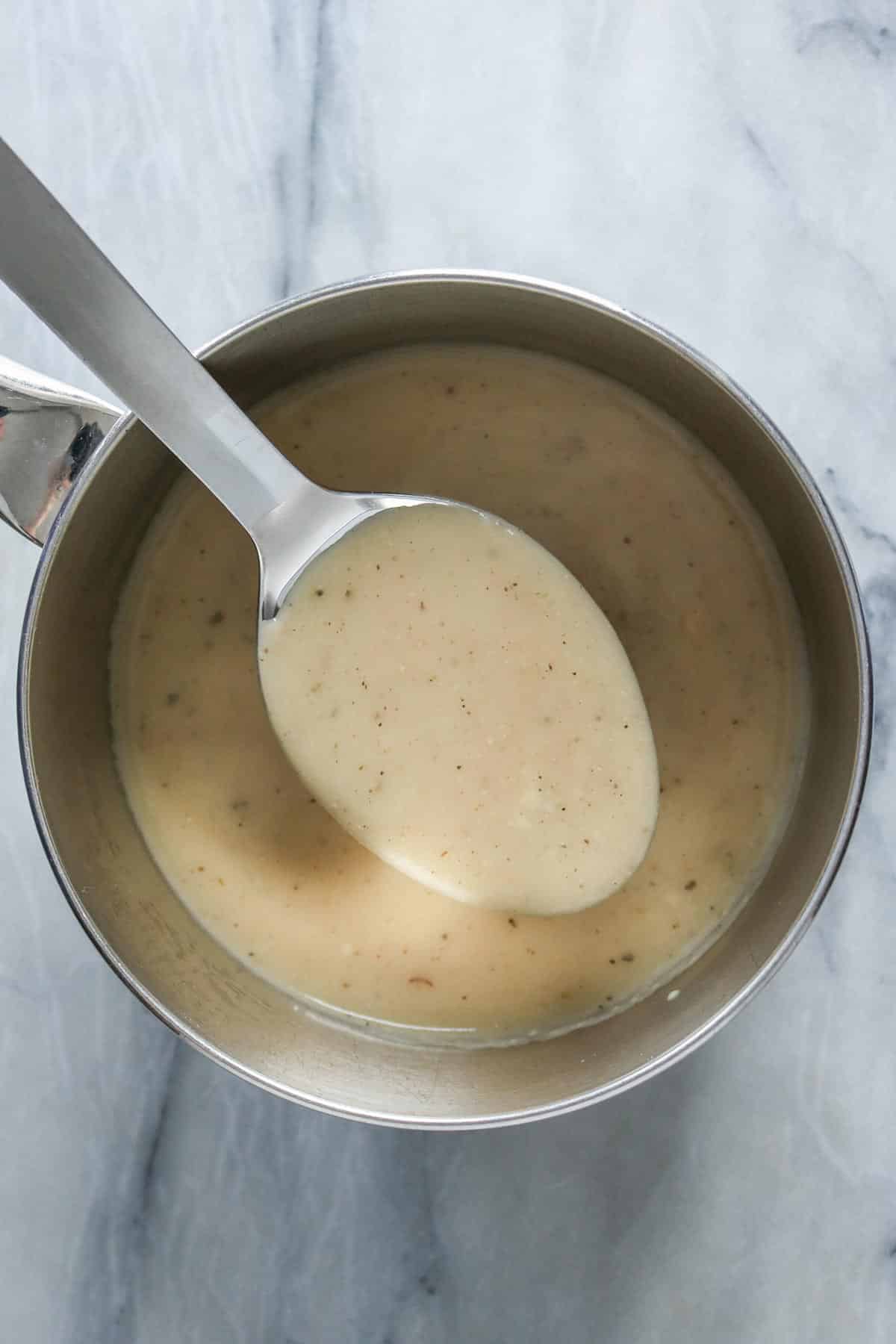
How To Use
Drink it straight-up from the gravy boat. Just kidding! Homemade gravy has lots of delicious use. Some of my favourite ways to use it are with:
- Mashed potatoes
- Fries and gravy (especially paired with dressing)
- Hot chicken, turkey or beef sandwich
- Poutine
- Open-faced ground beef sandwich
- Chicken pot pie
Leftovers and Storing
Properly store leftover gravy in an airtight container in the refrigerator for up to 2 to 4 days. Reheat before serving.
Reheating
To reheat leftover gravy, place into a saucepan and heat over medium heat, stirring occasionally, until it’s heated through.
Tip: The gravy will likely thicken when it’s refrigerated, so you can add a little more chicken broth to thin it out, if necessary. When reheating the gravy, I also find that it’s good to use a whisk to stir everything together (just to make sure there are no lumps).
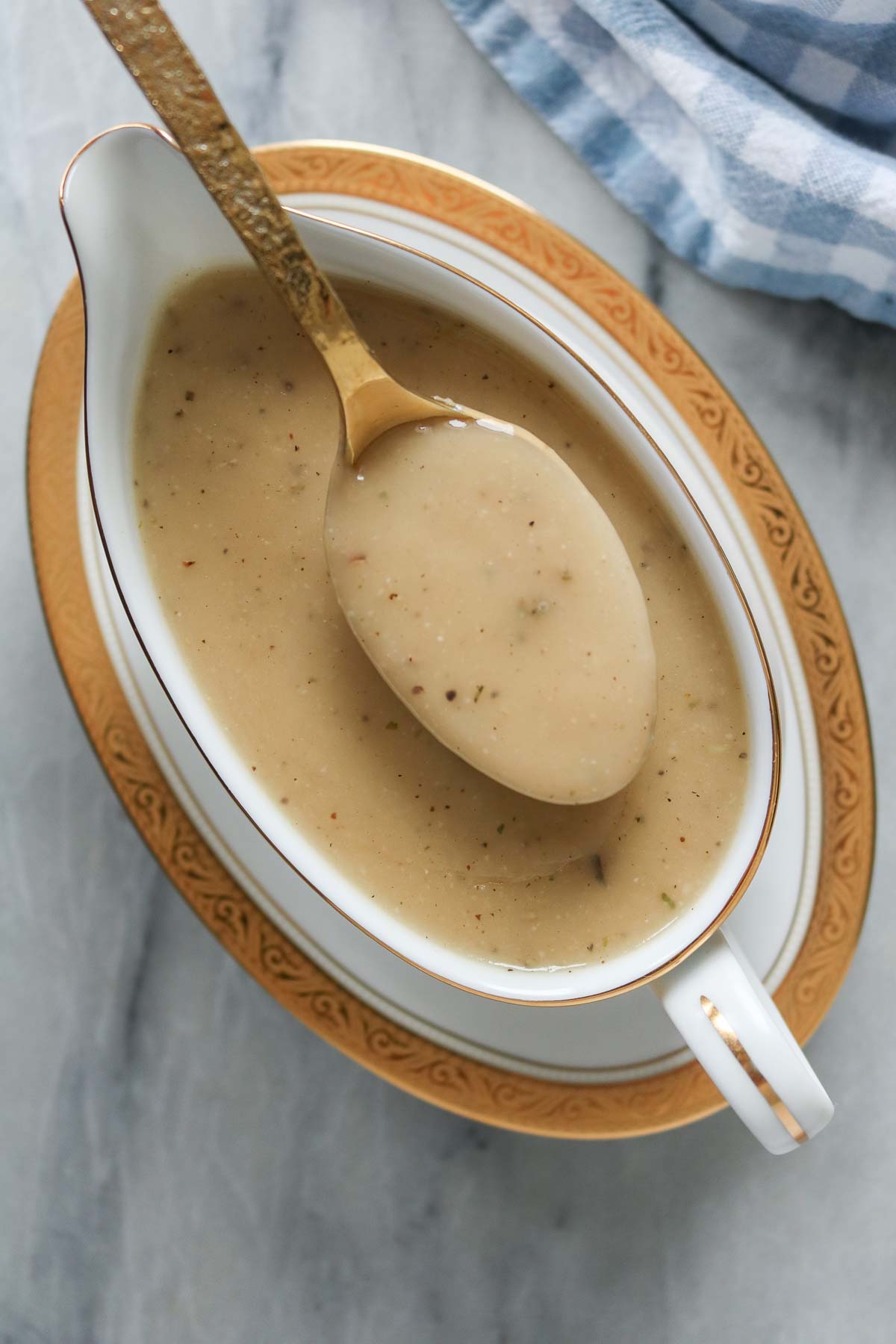
Tips for Making the Best Gravy
- Though this is a chicken gravy (because of the chicken broth), you can easily substitute the chicken broth for beef broth. Use whatever you have on hand or prefer.
- As mentioned, the type of chicken broth you use (plus your preference for seasoning) will greatly impact how much salt you add. Just add enough to taste. Remember, it’s easier to add than take away, so if you are unsure, it’s best to always add a little at a time until you get the flavour you want. I usually make this gravy with a reduced sodium chicken broth, but I’ve also made it with a no salt added chicken broth. The amount of salt that you need to add (when using one versus the other), can vary greatly. Just something to keep in mind.
- If you thicken your gravy too much, no worries! Just add a little more broth until you reach the consistency that you like best.
As you can see, it’s quite easy to make homemade gravy without drippings. If you do make this recipe (yay!), be sure to leave a comment below!
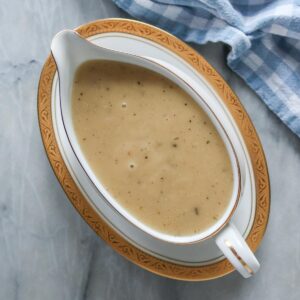
Homemade Gravy (Without Drippings)
Ingredients
- ¼ cup unsalted butter
- ¼ cup all-purpose flour
- 1.5 teaspoons onion powder
- ½ teaspoon garlic powder
- ½ teaspoon Herbes de Provence, or use summer savoury, sage, thyme, rosemary, marjoram or poultry seasoning
- 2 cups chicken broth, approximately (I used a reduced sodium chicken broth)
- 2 teaspoons Worcestershire sauce
- salt, to taste
- freshly ground black pepper, to taste
- Gravy browning, optional (to achieve desired gravy colour)
Instructions
- Melt butter in a small to medium saucepan over medium heat.
- Once the butter is melted, stir in flour. Whisk to combine and cook for about 1 to 2 minutes, while stirring continuously. Stir in onion powder, garlic powder and Herbes de Provence.
- Slowly whisk in ½ cup of chicken broth. The mixture will almost immediately get really thick. Add remaining broth (in ½ cup increments), stirring and cooking for 1 to 2 minutes until the gravy starts to thicken before adding more broth. Continue this process until all the broth is used and the gravy thickens and reaches the consistency you like best (for me, this usually takes about 8 to 10 minutes). When the gravy easily coats the back of a spoon, it's usually at a good consistency. If you overthicken your gravy, just add a little more broth and heat through.
- Once the gravy is at the consistency you like, stir in Worcestershire sauce and season to taste with salt and black pepper (for me, ½ teaspoon each was good, but the amount could vary depending on your preference, the variety of chicken broth you use and how salty it is, i.e., no salt added, low sodium, or regular). Remember, it's easier to add than to take away, so add a little salt at a time until you get it just right for you. At this point, if you feel like you'd like to add a little more Herbes de Provence (or your preferred seasoning), go for it.
- If you want a darker colour to your gravy, stir in some gravy browning as desired (optional).
A note on times provided: appliances vary, any prep and/or cook times provided are estimates only.
© Girl Heart Food Inc. Photographs and content are copyright protected.
Tried this recipe?
If you do make this recipe, thank you!! It would mean so much if you could leave a comment below. Love to know how you enjoyed it, and it helps other readers too!


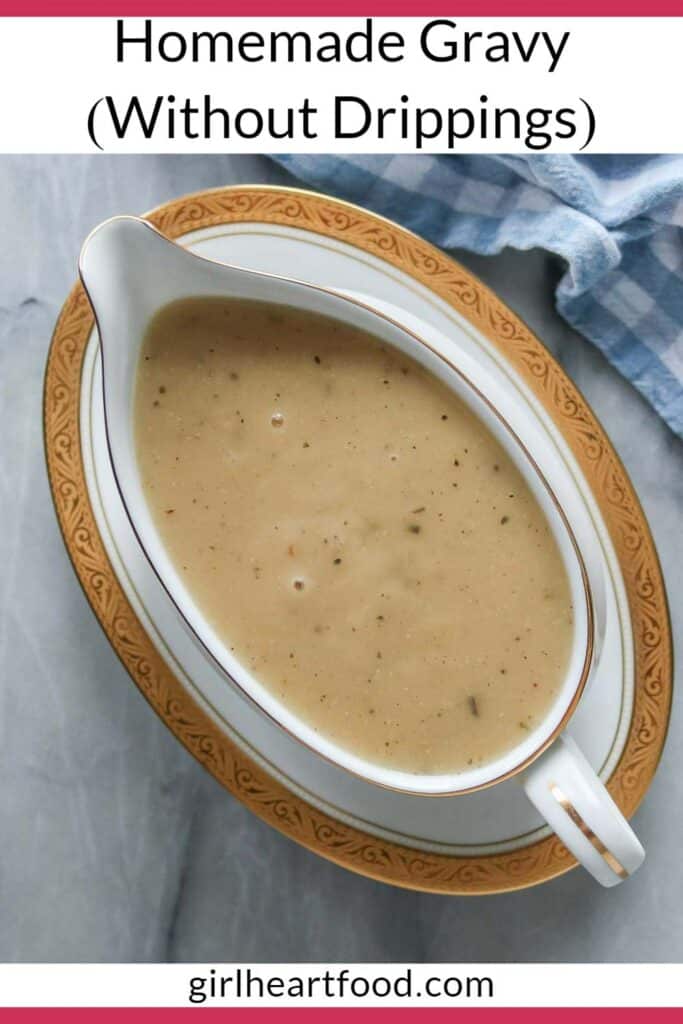
David @ Spiced
Ever since I switched to frying our turkey, we’ve gone to the dripless gravy. The lack of drippings is probably the only downside to frying the turkey. I love this version with the Worcestershire and Herbes de Provence. Who needs drippings when we can roll this way instead?? 🙂
Valentina
I did something similar but with vegetable stock — for the vegetarians at our Thanksgiving. This recipe sounds delicious and it’s such a great idea because (at least for me), I find it stressful to wait for the drippings to complete the grave. This way, it’s good to go ahead of time. 🙂 ~Valentina
Michelle
Such a great recipe, especially when you don’t have drippings on hand! I’d pour this all over my dressing/stuffing and happily enjoy that for the holidays 🙂